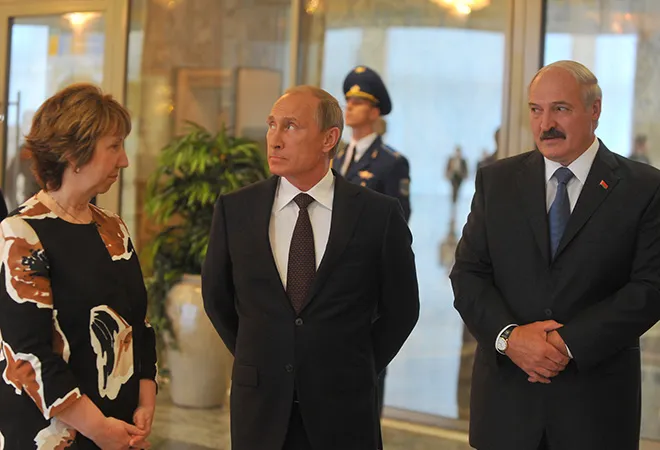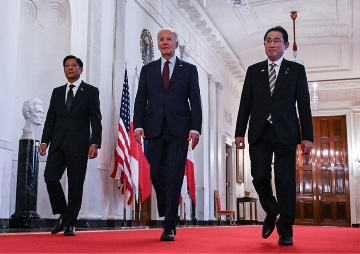
Two decades since Russia and Belarus signed a union treaty for establishing deeper integration, the two countries continue to debate the terms of the agreement without much success. The latest push was made in early February with the visit of Belarusian President Alexander Lukashenko to Sochi to hold talks with Russian President Vladimir Putin regarding the integration process within the union state.
The two leaders had also met in December 2019, but failed to arrive at an agreement, even as street protests erupted in Minsk at the same time opposing the integration, highlighting domestic skepticism about it.
This has led to speculation regarding Belarus’s next move — whether it would join Russia in a unified state, or would it maintain the status quo and mend relations with the West. In this backdrop, ahead of Lukashenko’s latest visit to Russia, the US Secretary of State Mike Pompeo was in Minsk to seek rapprochement with the former Soviet Republic, seeking to capitalise on the divergences.
The Treaty on the Creation of a Union State between Russia and Belarus was signed on 8 December 1999, but has never seen the light of the day. The agreement calls for cooperation on foreign policy, defence, social and economic policies with an aim of setting up a unified parliament and a single currency in the future. But two decades later, significant differences remain between the two sides on various issues. In late 2018, special working groups of both the states came up with 31 roadmaps for the vision of the union state out of which 21 were agreed upon in November 2019. The roadmaps primarily addressed issues of a common market for oil and gas, transport market, manufacturing, agriculture, etc.
Ahead of Lukashenko’s latest visit to Russia, the US Secretary of State Mike Pompeo was in Minsk to seek rapprochement with the former Soviet Republic, seeking to capitalise on the divergences.
This has taken place even as Russia has sought to reassert its influence in the post-Soviet space. Since the 2014 Ukrainian crisis and the subsequent breakdown of ties with Kiev, the attention has turned to other areas — including the idea of Greater Eurasia as well as the union treaty with Belarus. However, as Moscow pushed for integration talks towards the creation of a single state, the Belarusian President affirmed to protect his country’s sovereignty. This has strained the bilateral relationship, diminishing hopes of a full implementation of the treaty and leading to a rising trust deficit.
|
Belarus |
Russia |
| Area (sq. km) |
207,600 |
17,098,242 |
| Population (million) |
9,475, 174 |
146,800,000 |
| Annual GDP ( million $) |
59,643 |
1, 657,290 |
| GDP/capita ($) |
6,283 |
11,289 |
Source — Country economy
Geographically, Belarus serves as an important transit route between Russia and Europe, including for the world’s largest oil pipeline Druzhba onwards to Western Europe. Moscow also supplies about 33 billion cubic meters of gas to Europe via the Yamal-Europe gas pipeline passing through Belarus.

Source: European Dialogue
This energy relationship is the major revenue generator for both Russia and Belarus, but it is the latter that lacks leverage primarily due to lack of alternative suppliers. Energy has been used a leverage by Russia to get Minsk to accede to deeper political and economic integration, even halting oil supplies as the talks hit a plateau in January.
While Belarus imported about 80,000 tons of crude oil from Norway in February to diversify its options, importing oil from other countries would prove to be more expensive for Belarus. Last year, Belarus imported 17.6 million tons of oil from the Russian Federation. In January, Belarus received only 500,000 tons of Russian oil, four times less than it planned to obtain. While Minsk has aimed to cut down on import of Russian oil to about 40%, it is a difficult proposition since crude oil from Russia with reduced subsidies is much cheaper and there are limited transit options.
Russia and Belarus have been engaged in an oil dispute for the past decade now over pricing disagreements. While Russia has been supplying subsidised energy to Belarus, it is no longer willing to continue to do so indefinitely or without significant political and strategic gains. As a result, subsidies for Belarus has been a matter of contention between the two states, with Putin noting that it would be a mistake to “start subsidising Belarus (more) given the unresolved issue of the union state’s build up.”
While Russia has been supplying subsidised energy to Belarus, it is no longer willing to continue to do so indefinitely or without significant political and strategic gains.
After the contracts expired on 31 December, Russia halted crude supplies to the country with ongoing negotiations around transit fees and amount of crude exported to Belarus. With changes to Russian oil export duties, Minsk laments incurring losses in terms of revenue. In order to boost revenue, Russia had decided to cut the export tax on oil from 30% to zero and raise the tax on oil production from 2019–24. Belarus estimates it will lose $300-$400 million a year due to these changes. In recent developments, Belarus has been offered compensation for the “lost earnings on oil customs duty” due to changes in the Russian tax regime.
Minsk has also aired its grievances about the unfair pricing of natural gas. According to the president, the price it pays for Russian natural gas is unfair. Even the offer of US Secretary of State Mike Pompeo to meet all of Belarus’s energy needs is unlikely to have an immediate impact, given that at present their bilateral oil and gas trade stands at a miniscule level. As Minsk continues to search for alternatives, list of potential suppliers has also included Saudi Arabia, UAE and Azerbaijan.
Despite these constraints in dealing with its powerful neighbor, Lukashenko has rallied the people by appealing to their nationalism, calling for preserving the sovereignty of the state. Focusing on promoting a new national identity distinct from Russia, public opinion has been unified against any integration of the two states. Protests witnessed in December 2019 on the proposed integration were also supported by opposition parties such as Christian Democrats and United Civic Party. The government is working towards promoting the Belarusian language along with art and culture giving impetus to ‘soft Belarusianisation’ where the state is making the shift towards projection of its soft power. It has also diversified its foreign policy, including ties with the US, EU and China, based on a pragmatic approach. However, Russia remains its primary trade and energy partner and Belarus exports about 40 percent of its goods to Russia.
Belarus’ top five trading partners:
| Countries |
Trade Volume (in billion $) |
| Russia |
12.95 (38.5%) |
| Ukraine |
4.1 (12.1%) |
| United Kingdom |
3.1 (9.2%) |
| Germany |
1.4 (4.3%) |
| Netherlands |
1.4 (4.3%) |
The European Bank for Reconstruction and Development invested $433 million in Belarus in 2019 and foreign investment in the country was close to $10 billion in 2019. Apart from Russia, UK, Cyprus and Poland are the main investors in Belarus. According to the National Bank of Belarus data, Russia accounts for 55% of all the foreign direct investments in Belarus. The investments from US have been less forthcoming due to the economic climate and Chinese investments in Belarus have risen, concentrating heavily on infrastructure projects. Though widening its friend circle, for Belarus it might not prove to be a counterweight to Russia.
As a member of Eurasian Economic Union, which gives a wide access to the Russia’s vast market, the Belarusian economy has reaped benefits. It is the most integrated country in the EAEU in terms of trade. In 2018, the state’s foreign trade witnessed significant improvements. Without the necessary economic reforms, the economy survived through cheap loans and credit from Moscow.
The geopolitical gains for Russia of maintaining a hold over the post-Soviet space and bordering NATO countries of Lithuania and Latvia cannot be underestimated. But Belarus remains worried about the loss of sovereignty.
Russia also maintains two military facilities in Belarus, the Vileyka VLF transmitter and Missile Attack Early Warning System site in Hantsavichy. The extension of lease for both the facilities is ongoing. Last year, Belarus denied the request of a Russian Air Force military base, a decision that was described by Moscow as ‘unfortunate’. In 2015, Belarus purchased 12 Mi-17 transport helicopters and in 2017, it ordered 12 Su-30MK fighter jets and 100 Russian Tor missile systems. This deal was worth $145 million. Belarusian firms also supply Russia with military equipment such as optics, electronics, command and control systems etc. Both the states have been undertaking military drills as well. The Zapad exercise occurs every four years.
Despite the upper hand Moscow enjoys, the former superpower does not want to be seen as being overly coercive in the ongoing talks and risk a Ukraine-like scenario. The geopolitical gains for Russia of maintaining a hold over the post-Soviet space and bordering NATO countries of Lithuania and Latvia cannot be underestimated. But Belarus remains worried about the loss of sovereignty. In an election year, Lukashenko has been treading carefully, with one eye on getting re-elected while seeking concessions from Russia and looking at ways to diversify the economy.
As of now, prospects for talks stretching on seem more likely than any decision on establishment of a union state. This is especially because attention has now turned to the threat arising out of COVID-19 pandemic, making the process of diversification even more difficult for Belarus during the time of a global recession.
The author is a research intern at ORF.
The views expressed above belong to the author(s). ORF research and analyses now available on Telegram! Click here to access our curated content — blogs, longforms and interviews.




 Source: European Dialogue
Source: European Dialogue
 PREV
PREV

